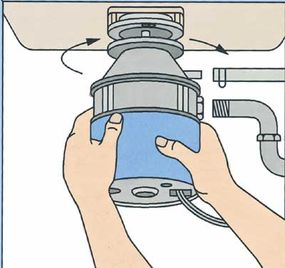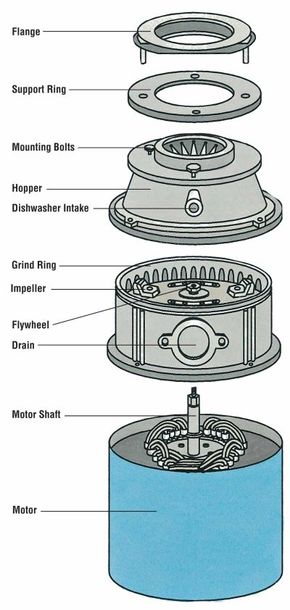How to Repair a Garbage Disposal
Garbage disposals are handy kitchen appliances that some consider a luxury and others deem a necessity. Disposers can quickly liquefy waste from food preparation or leftovers. When inoperative, they can also be a frustration, requiring that all food within be removed before repair.
Fortunately, with minimal maintenance, a garbage disposal can last many years without major repair. Simple maintenance includes ensuring that a disposer's enemies -- grease, large items, hard items, fibrous foods -- be eliminated from its diet.
Advertisement
Also make sure that water is running while the disposal is operating so that ground-up kitchen waste can be swept down the drain and not solidify inside the appliance.
How Garbage Disposals Work
A garbage disposal is a motorized small appliance. The motor turns a flywheel to which impellers are loosely attached. Food waste within the chamber is repeatedly hit and cut by these rotating impellers, grinding it into small particles that can be flushed through the drain pipe and into the septic system.
Some garbage disposals include an intake line for a dishwasher. The entire unit is attached to the sink using a flange, ring, and mounting bolts.
How to Repair a Garbage Disposal
Common garbage disposal repairs include servicing a flywheel, hoses and seals, and a worn impeller. Here are the step-by-step instructions for these repairs.
Servicing the flywheel: The flywheel in a garbage disposal rotates to spin the impellers that shred the food waste. If the flywheel doesn't turn, the disposer doesn't do its job. A stuck flywheel can also burn out a motor if left on too long. Fortunately, a flywheel is typically easy to free. To free the flywheel:
Step 1: Check the bottom side of the disposal for a six-sided (hex) hole.
Step 2: If it has one, look for a hex wrench in a pouch on or near the disposal. The hex wrench is used to rotate the motor shaft and flywheel without having to access the inside of the garbage disposal. If you don't find one, check your toolbox or purchase one.
Step 3: Simply insert the hex wrench in the hex hole and rotate it in a circle in both directions to free the flywheel.
If there is no hex hole, insert a shortened broom handle through the drain hole, resting one end at the side of an impeller. Gradually apply leverage to move the impeller in one direction or the other to free up the flywheel.
Servicing Hoses and Seals: A common complaint about garbage disposals is that they leak water into the cabinet below. By studying the leaked water and its location, you can often determine its source.
Standing water with discoloration from food means the drain pipe or the dishwasher intake is leaking. If the water is at all warm, it is probably from the dishwasher. If the standing water is clear, it may have come from the sink before the water entered the disposal. To assess a leak and replace the seal:
Step 1: Place a hand at various locations around the disposal. You can sometimes pinpoint the source by feeling water run across your hand.
Step 2: If the leakage is from underneath the garbage disposal, it is probably leaking through the flywheel seal and into the motor. In this case, you will need to remove the garbage disposal from the drain system. Disassemble the unit and replace the seal -- or take it in for service.

Servicing Worn Impellers: To remove a garbage disposal to sharpen impellers:
Step 1: Unplug the garbage disposal, remembering to trip the circuit breaker first or remove the fuse at the main electrical box if the disposal is wired directly into the house.
Step 2: Remove all hose fittings leading into or away from the disposal. Some garbage disposals can then be removed by twisting to free them from the support ring. Others require that the unit be unscrewed from the ring. Remember that a garbage disposer is a relatively heavy small appliance, so freeing it will suddenly put its full weight in your hands.
Step 3: To service worn impellers on many models, you must remove the flywheel. Lock the flywheel in place with a screwdriver, then loosen the flywheel lock nut.
Step 4: Once the flywheel is removed, the impellers can be removed or sharpened in place. If the impellers cannot be sharpened, the flywheel assembly will need to be replaced.
Your vacuum cleaner is broken? Say it isn't so. Don't let the dirt pile up -- check out the tips in the next section for repairing vacuum cleaners.
